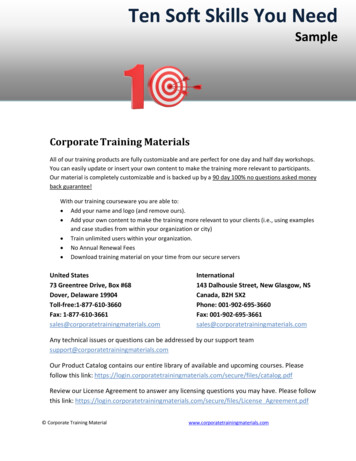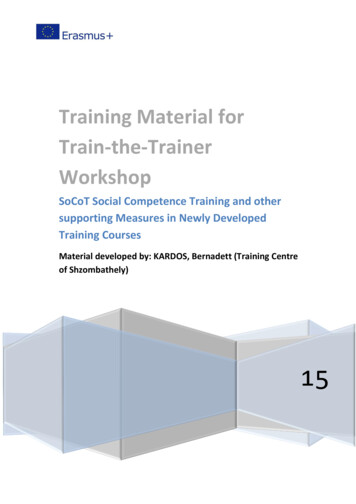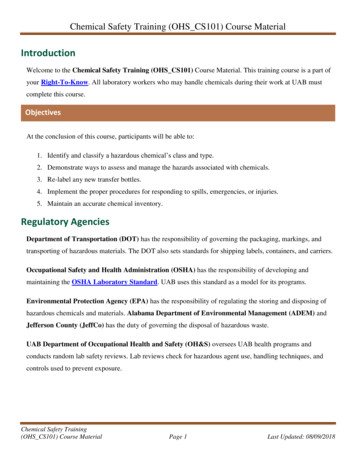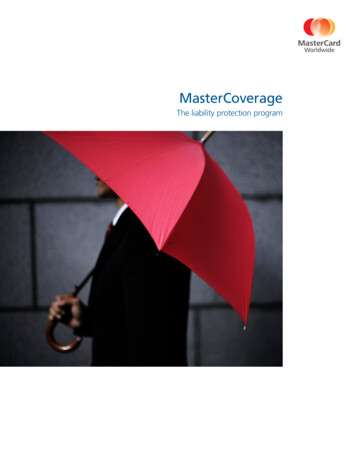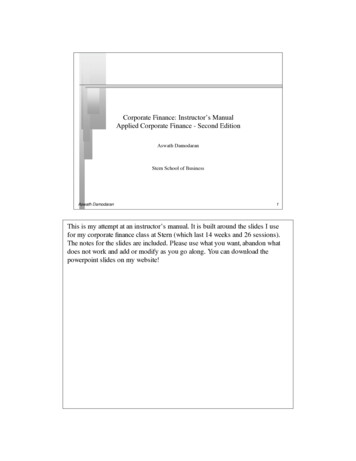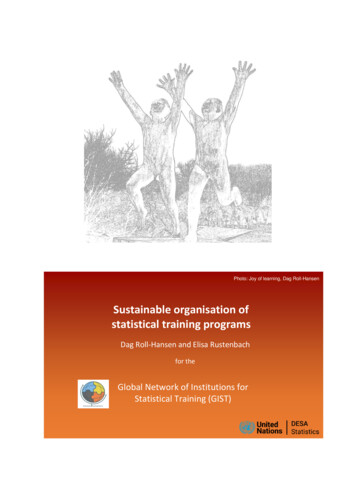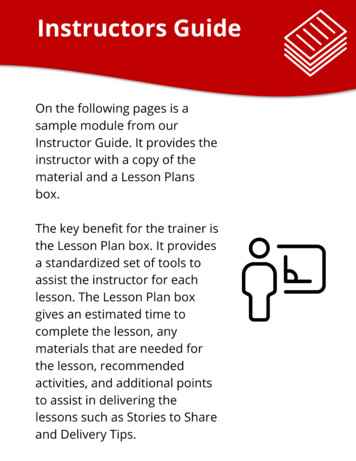
Transcription
Corporate Training Materialwww.corporatetrainingmaterials.com
The body never lies.Martha GrahamModule Two: Communicating with Body LanguageWe are constantly communicating, even when we are not speaking.Unspoken communication makes up over half of what we tell othersand they tell us. It affects our work and personal relationships.Improve negotiating, management, and interpersonal skills bycorrectly interpreting body language and important signals.Learning a New LanguageIn many ways understanding body language is like learning a foreign language. There are afew tips that make learning any language, even a nonverbal one, easier.Tips: Set Goals: Make sure that your goals are realistic and have specific timelines. Devote time to learning: Schedule time to practice. Do not rely on spare time. Practice daily: Hone skills by continued practice. Enjoy the process: You are not in school. Relax and have fun with your new skill.Estimated Time8 minutesTopic ObjectiveShare ways to learn nonverbal communication. Corporate Training Materialwww.corporatetrainingmaterials.com
Learning a LanguageTopic SummaryPrepare for learning body language.Materials RequiredWorksheet 1-Language TipsPlanning ChecklistNoneRecommended ActivityComplete the worksheet individually. Discuss your answers with the rest ofthe class.Stories to ShareShare your goals and practice schedule with the group.Delivery TipsEncourage participants to discuss their ideas, but do not force anyone.Review QuestionsWhat is body language similar to learning?The Power of Body LanguageUnderstanding body language does more than improve relationships. You willgain insight into the thoughts and feelings of those around you. Because it is nota conscious form of communication, people betray themselves in their bodylanguage. Body language is powerful in several ways.The Power of Body Language: It is honest: Body language conveys truth, even when words do not. Creates self-awareness: Understanding body language helps you identify your own actions thathinder success. Understand feelings: Body language shows feelings and motive such as aggression, submission,deception, etc. Use these as cues to your communication. Enhance listening and communication skills: Paying attention to body language makes someonea better listener. Picking up on gestures and cues helps you understand what is really being said.Estimated Time8 minutesTopic ObjectiveExplore the power of body language.Topic SummaryThe Power of Body Language Corporate Training Materialwww.corporatetrainingmaterials.com
Discuss how body language gives power and prevents problems.Materials RequiredFlipchart/MarkerPlanning ChecklistNoneRecommended ActivityHave participants discuss personal experiences related to body language,either personal or observed. For example, ignoring aggressive body languageof a coworker who later made threats. List some on the flip chart andhighlight body language signs.Stories to ShareShare any relevant personal experiences that relate to body language.Delivery TipsEncourage everyone to participate.Review QuestionsWhat is not a conscious form of communication?More than WordsMuch of the way people communicate is nonverbal. Body language specificallyfocuses on the physical aspects of conversation, not tone, or pitch. It includes thefollowing characteristics.Body Language: Proximity: The distance between people Positioning: Position of a body Facial expression: The eyes are particularly noticed. Touching: This includes objects, people, and themselves. Breathing: The rate of respiration is telling.Estimated Time10 minutesTopic ObjectiveExplore body language.More than WordsTopic SummaryOutline body language.Materials Required Corporate Training MaterialPictures or computer, Flipchart/Markerwww.corporatetrainingmaterials.com
Planning ChecklistFind a selection of pictures that shows different facial expressions, postures,etc. Create a presentation on the computer to bring to class, or print thepictures.Recommended ActivityPass the pictures around or use the presentation. Ask the class to interpretwhat the pictures communicate. List the ideas on the flipchart.Stories to ShareShare any relevant personal stories.Delivery TipsTell the participants to use their gut reactions. They are not expected toready body language yet.Review QuestionsWhat is particularly noticed in facial expressions?Actions Speak Louder than WordsOur impressions of each other are based on more than words. People can havecordial conversations and not like each other. The actions that we take are strongerthan our words. For example, a person may dismiss someone using body languageand not saying anything negative. Like it or not, our body language makes a lastingimpression on the people around us.What Actions Can Say: Deception Confidence Nerves Boredom Emotions Attraction Being open Being closed offPlease note that this is not an exhaustive list of what body language can communicate.Estimated Time Corporate Training Material10 minuteswww.corporatetrainingmaterials.com
Topic ObjectiveExplore what body language can say.Actions Speak Louder than WordsTopic SummaryUnderstand the importance of body language on first impressions.Materials RequiredFlipchart/MarkerPlanning ChecklistNoneRecommended ActivityHave the participant’s think of problematic social encounters that were notbased on spoken communication, and share their experiences. What did thebody language communicate and how? List common communications on theflipchart.Stories to ShareShare a relevant personal story. It does not have to be a professional story.For example, share about a bad date.Delivery TipsEncourage everyone to participate.Review QuestionsWhat is more important than words?Practical IllustrationJim had to hire a new personal assistant. He needed someone organized and personable.Jen answered all of the interview questions perfectly. She had the necessary training andeducation, so Jim hired her. After a few weeks, some of Jim’s coworkers complainedabout her behavior. They accused her of being aggressive and insubordinate, but shenever said anything specifically rude or hostile. Her tone and body language, however,were extremely aggressive. For example, she rolled her eyes when people asked herquestions. Jim had to coach Jen on her nonverbal communication, and he added a body languageevaluation to his interview process.Estimated Time5 minutesTopic ObjectiveOutline the body language Practical Illustration.Practical IllustrationTopic SummaryDiscuss body language in the workplace.Materials Required Corporate Training MaterialNonewww.corporatetrainingmaterials.com
Planning ChecklistNoneRecommended ActivityDiscuss the results of the Practical Illustration. Would her aggression havebeen noticeable in the interview?Stories to ShareShare any relevant personal stories.Delivery TipsEncourage everyone to participate.Review QuestionsWhat position was Jim hiring for? Corporate Training Materialwww.corporatetrainingmaterials.com
Module Two: Review Questions1.) Goals should be ?a)b)c)d)ConcurrentCompatibleRevisedRealisticGoals should be realistic. They should also have timelines.2.) How often should body language be practiced?a)b)c)d)HourlyWeeklyDailyMonthlyLike any language body language requires practice. It should occur every day.3.) What does body language NOT Body language does not improve sight. It can improve listening and understanding, whichimproves success.4.) What should provide cues to your communication?a)b)c)d)Your own feelingsFeelings of othersThe tone of voiceThe truthBody language betrays emotions. These feelings should provide cues to your communication.5.) What is the term for the distance between eningProximity is the distance between people. This distance is part of a person’s body language. Corporate Training Materialwww.corporatetrainingmaterials.com
6.) What is NOT included in touching?a)b)c)d)SelfOthersPositioningObjectsThe way people touch objects, others, or themselves is important. Positioning is anothercategory.7.) makes a lasting impression.a)b)c)d)Body languageWordsAppearanceClothingBody language makes a lasting impression.8.) Body language can communicate Body language can communicate when someone is being deceptive.9.) What is an unacceptable form of body communication?a)b)c)d)YellingAggressionEye rollingAll of the aboveAll of the options are negative forms of body language.10.) Learning to interpret body language is a difficult process.a) Trueb) FalseEnjoy the process: You are not in school. Relax and have fun with your new skill. Corporate Training Materialwww.corporatetrainingmaterials.com
Corporate Training Materialwww.corporatetrainingmaterials.com
Corporate Training Materialwww.corporatetrainingmaterials.com
Corporate Training Materialwww.corporatetrainingmaterials.com
Corporate Training Materialwww.corporatetrainingmaterials.com
Corporate Training Materialwww.corporatetrainingmaterials.com
Corporate Training Materialwww.corporatetrainingmaterials.com
Corporate Training Materialwww.corporatetrainingmaterials.com
Corporate Training Materialwww.corporatetrainingmaterials.com
Corporate Training Materialwww.corporatetrainingmaterials.com
Sample Worksheet 1Language TipsCreate your own action plan based on the tips of the section Goals: Hours committed to learning each week: Daily Practice Schedule Corporate Training Materialwww.corporatetrainingmaterials.com
Icebreaker: House of CardsPURPOSE1. To help participants get to know each other2. To identify participants’ goals for the sessionMATERIALS REQUIRED3. One playing card per participant, with an equal amount of cards from each suit4. Several sets of markers5. Flip chart paperPREPARATIONPass out one playing card to each participant, face-down.ACTIVITYOn your cue, ask participants to turn over their playing cards. They are to find others with their suit, butthey are not allowed to talk or show their card. For example, if a person had a spade, they may illustratethat by pretending to dig a hole.Once participants are in their groups, they are to introduce themselves and come up with a list of fivethings that they would like to learn during the workshop.DEBRIEFOnce groups have created their list, bring participants back together. Have each group present their listand combine topics on the flip chart. Use this as a guide during the workshop. If there are any topicsthat will not be covered, let participants know where they can find more resources (such as follow-upworkshops or materials from the Recommended Reading List). Corporate Training Materialwww.corporatetrainingmaterials.com
Corporate Training Materialwww.corporatetrainingmaterials.com
CERTIFICATE OF COMPLETION[Name]Has mastered the courseBody Language BasicsAwarded this day of e , 20Presenter Name and Titlewww.corporatetrainingmaterials.com Corporate Training Material
Have participants discuss personal experiences related to body language, either personal or observed. For example, ignoring aggressive body language of a coworker who later made threats. List some on the flip chart and highlight body language signs. Stories to Share Share any relevant personal experiences that relate to body language.
